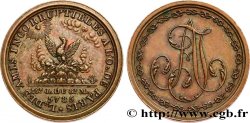fjt_511959 - FREEMASONRY GRANDE LOGE DE FRANCE, VISITE A BERLIN 1908
180.00 €(Approx. 192.60$ | 154.80£)
Quantity
Add to your cart

Type : GRANDE LOGE DE FRANCE, VISITE A BERLIN
Date: 1908
Mint name / Town : Grande Loge de France
Metal : bronze
Diameter : 38 mm
Orientation dies : 12 h.
Weight : 21,88 g.
Edge : Lisse
Rarity : INÉDIT
Coments on the condition:
Bélière
Catalogue references :
Predigree :
Exemplaire provenant de la Collection JCT
Obverse
Obverse legend : ANÉPIGRAPHE.
Obverse description : Dans un cercle perlé, un autel au fond radiant reposant sur un pavé mosaïque, sur le devant équerre sur compas (au grade d’apprenti). En arrière-plan autel maçonnique.
Reverse
Reverse legend : ZUR / ERINNERUNG / AN DEN BESUCH / DER / GRANDE LOGE DE FRANCE / BEI DEN / 3 GROSS-LOGEN ZU BERLIN / 9-12 MAI 1908 .
Reverse description : Dans un cercle perlé en huit lignes.
Reverse translation : En souvenir de la visite de la Grande Loge de France aux 3 Grandes Loges à Berlin 9-12 mai 1908 .
Commentary
De rite et d’obédience de la G.L.D.F. Cette médaille est un souvenir de la visite d’une délégation de Francs-maçons français appartenant à la Grande Loge de France, invités par les Loges de Berlin . Médaille historique de la célébration des retrouvailles maçonniques entre Frères ennemis (depuis la guerre franco-allemande de 1870), qui eurent lieu à Berlin du 9 au 12 mai 1908. Visite de la Grande Loge de France aux 3 Grandes Loges de Berlin, dites de " Vieille Prusse", leur siège est à Berlin. Les relations fraternelles entre les Maçons français et allemands avaient été interrompues en 1870. On doit la réconciliation grâce à l’intiative du’un Maçon Luxembourgeois : le Vénérable Joseph Junck, Grand maître de l’Ordre au Grand Duché. A noter que les manifestations Maçonniques Internationales pour la Paix, de 1907 à 1914, furent une initiative “de la base”, ce qui déplut fort aux 3 Grandes Loges allemandes. La rencontre de 1908 à Berlin fut une tentative de rapprochement, décidées par les “dirigeants maçonniques” des deux pays et du président de “l’Association Maçonnique Internationale”, qui succéda au “Bureau International de Relations Maçonniques”. La guerre interrompit ces rencontres qui ne reprirent qu’en 1925 à Bâle. Médaille Inédite au Labouret.








 Report a mistake
Report a mistake Print the page
Print the page Share my selection
Share my selection Ask a question
Ask a question Consign / sell
Consign / sell
 Full data
Full data



